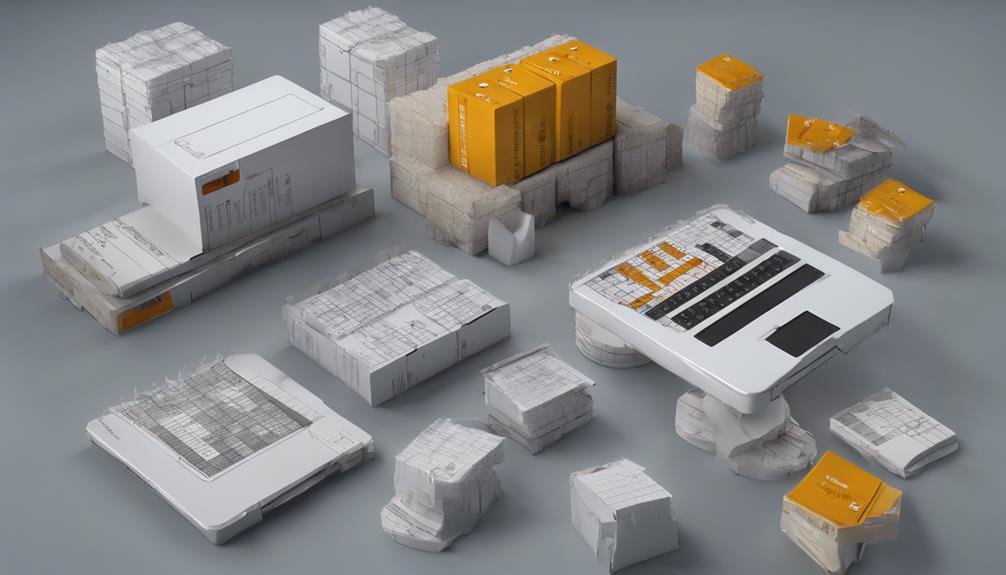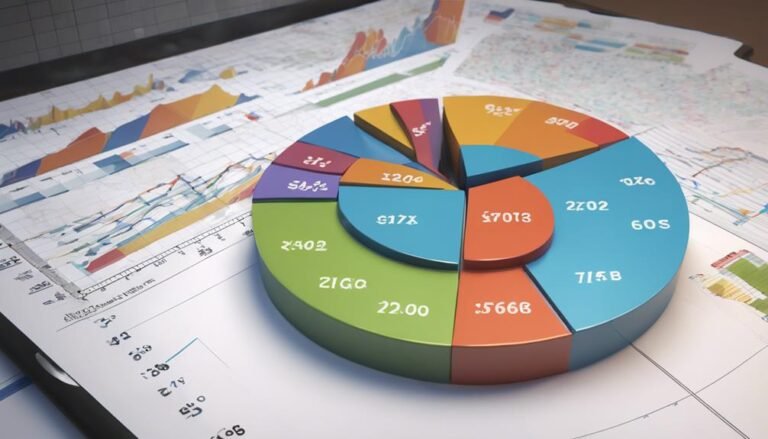Cost Accounting: Methods and Importance
Cost accounting methods are crucial for understanding your product/service costs accurately. By categorizing costs and using methods like ABC, job costing, and process costing, you gain insights into cost behavior and allocation. This allows for precise expense forecasting and strategic decision-making. Cost analysis tools aid in profitability assessment, cost control, and pricing strategies. Allocating costs correctly enhances financial performance and informs decisions effectively. Dive deeper into cost allocation's impact on profitability and how it enables targeted cost-cutting measures to optimize financial performance further.
Key Takeaways
- Cost accounting methods include traditional costing, activity-based costing, job costing, and process costing.
- Accurate cost allocation enhances financial performance and aids in decision-making.
- Understanding variable vs. fixed costs is crucial for total cost calculation and pricing strategies.
- Contribution margin analysis helps optimize profitability and pricing decisions.
- Implementing cost control measures involves meticulous expense analysis and budget variance assessments.
Overview of Cost Accounting
In cost accounting, the primary objective is to accurately determine and allocate the costs associated with producing goods or services. Cost reduction strategies play an important role in managing expenses effectively. By analyzing cost behavior, you can understand how costs change in relation to various factors such as production levels or sales volume. This analysis helps in making informed decisions to optimize costs and enhance profitability.
Cost reduction strategies focus on minimizing expenses without compromising the quality of goods or services. Understanding cost behavior is essential for implementing these strategies successfully. By categorizing costs as fixed, variable, or mixed, you can identify areas where cost savings can be achieved. For instance, knowing that certain costs remain constant regardless of production levels allows you to devise plans to reduce them efficiently.
Cost behavior analysis enables you to forecast expenses accurately and develop budgets that align with business goals. By implementing cost reduction strategies based on this analysis, you can improve cost efficiency and drive overall performance.
Traditional Costing Methods
Utilize traditional costing methods to allocate and track costs effectively in your business operations. Traditional costing methods involve allocating overhead costs based on a predetermined overhead rate, usually calculated using direct labor hours or machine hours. While these methods are straightforward and easy to implement, they may not always provide accurate cost allocations. One of the challenges with traditional costing methods is that they can lead to cost distortions, especially in environments where overhead costs are driven by factors other than direct labor or machine usage.
When comparing traditional costing methods to newer approaches like Activity-Based Costing (ABC), traditional methods are generally simpler and less expensive to implement. However, they may not capture the true cost drivers of a product or service accurately. Traditional costing methods are more suitable for businesses with standardized operations and where overhead costs are relatively low compared to direct costs. Understanding the differences between traditional costing and ABC methods can help you choose the most appropriate cost allocation strategy for your business.
Activity-Based Costing (ABC)
Activity-Based Costing (ABC) provides a more accurate and detailed way to allocate costs by identifying specific activities that drive overhead expenses. When implementing ABC, cost drivers analysis is key to understanding the factors that greatly influence costs. This method focuses on the cause-and-effect relationship between activities and costs, offering a more precise allocation of expenses based on actual resource consumption.
In ABC implementation, three essential aspects play an important role in determining accurate cost assignments:
- Identification of Cost Drivers: ABC emphasizes identifying the activities that consume resources and contribute to overhead costs, allowing for a more detailed analysis of cost distribution.
- Analysis of Resource Consumption: By evaluating how resources are consumed by different activities, ABC enables a more detailed understanding of cost behavior and helps in pinpointing areas for cost optimization.
- Evaluation of Activity Levels: Understanding the levels of activity within an organization is crucial for determining the true drivers of costs and ensuring that resources are allocated efficiently based on these activity levels.
Job Costing
Implementing job costing in your organization allows for detailed tracking of costs associated with specific projects or jobs, enabling accurate financial analysis and resource allocation. Job costing is vital for businesses that produce unique products, provide custom services, or undertake projects on a job order basis. It involves assigning costs to a specific job or project, allowing for a more precise calculation of the expenses incurred. This method of cost allocation provides transparency into the profitability of each job and helps in making informed decisions regarding pricing, resource utilization, and overall project management.
| Job Costing Table | ||
|---|---|---|
| Cost Elements | Description | Example |
| Direct Materials | Raw materials directly | Cost of wood for |
| attributable to a job | furniture making | |
| Direct Labor | Wages of labor directly | Wages of carpenters |
| involved in the job | working on a job | |
| Manufacturing Overhead | Indirect costs related to | Depreciation of |
| production not directly | machinery used in | |
| traceable to a specific job | manufacturing |
Process Costing
Process Costing allocates costs to products based on the average costs of processes involved in producing those products, offering a systematic approach to determine the cost per unit in continuous production environments. In this method:
- Weighted average: Costs are calculated by taking the total costs for a specific period and dividing them by the equivalent units produced during that period. This method smooths out fluctuations in costs by spreading them evenly across all units.
- Equivalent units: These represent the number of complete units that could have been produced with the total amount of work done during a particular period. It considers work done both on units completed and those in process.
- Cost per equivalent unit: This is calculated by dividing the total costs (direct materials, direct labor, and overhead) by the equivalent units produced. It provides a standardized measure of cost that can be compared across different periods or products.
Variable Vs. Fixed Costs
Differentiating between variable and fixed costs is important in cost accounting as it helps in determining the cost structure of a product or service.
Variable costs fluctuate in direct proportion to the level of production or sales. These costs include raw materials, direct labor, and commissions. Understanding how variable costs behave is vital for management decisions, as they impact the contribution margin and break-even point of a product or service.
On the other hand, fixed costs remain constant regardless of the production or sales volume. These costs include rent, salaries of permanent employees, and insurance premiums. Recognizing the distinction between variable and fixed costs enables businesses to calculate their total costs accurately and make informed pricing strategies.
Cost-Volume-Profit Analysis
When analyzing Cost-Volume-Profit, you'll focus on calculating the Break-Even Point and understanding Contribution Margin.
These elements are vital in determining the level of sales needed to cover all costs and start generating profit.
Break-Even Point Calculation
To understand the break-even point calculation in cost-volume-profit analysis, you need to determine the point at which total revenue equals total costs. This analysis plays a significant role in making important business decisions.
Here are three key aspects to keep in mind:
- Fixed Costs: These are costs that remain constant regardless of the level of production or sales. Identifying fixed costs is essential for calculating the break-even point accurately.
- Variable Costs: Variable costs fluctuate depending on the level of production or sales. Understanding how these costs change with production volume is essential for break-even analysis.
- Contribution Margin: This is the difference between total sales revenue and total variable costs. It represents the amount available to cover fixed costs and contribute to profit after covering variable costs.
Contribution Margin Analysis
In contribution margin analysis, understanding the relationship between total sales revenue, total variable costs, and fixed costs is crucial for evaluating profitability. This analysis helps in determining the amount of revenue that will contribute towards covering fixed costs and generating profit.
By calculating the contribution margin ratio (contribution margin per unit divided by the selling price per unit), you can assess the impact of sales volume on profitability. Profitability analysis using contribution margin assists in making decisions regarding product pricing, cost control measures, and sales strategies. It enables managers to focus on optimizing prices to maximize profits while covering fixed costs.
Importance of Cost Allocation
Cost allocation plays an essential role in accurately determining the true cost of products or services within a business. When considering cost allocation strategies, benefits arise such as a more precise understanding of the actual expenses associated with each product or service. This process aids in making informed decisions regarding pricing and resource allocation within the company.
Additionally, the impact of cost allocation on profitability is significant. By correctly assigning costs to specific products or services, businesses can identify which areas are the most profitable and which may need improvement. This detailed cost breakdown allows for targeted cost-cutting measures and helps in optimizing the overall profit margins.
Effectively, effective cost allocation isn't just about assigning expenses; it's a strategic tool that enables businesses to enhance their financial performance and make informed decisions based on accurate cost data.
Cost Accounting for Decision Making
When making decisions, you must utilize cost analysis tools to understand the financial implications. Calculate profit margins accurately to gauge the profitability of different choices.
These tools are essential for informed decision-making in cost accounting.
Cost Analysis Tools
Utilize a variety of cost analysis tools to enhance decision-making processes within the domain of cost accounting.
- Cost Comparison Analysis: Compare the costs of different products, services, or projects to identify cost-saving opportunities and make informed decisions on resource allocation.
- Expense Tracking Tools: Use specialized software or systems to track expenses accurately, categorize them effectively, and monitor spending patterns over time.
- Break-Even Analysis: Determine the point at which total revenues equal total costs, helping you understand the level of sales needed to cover all expenses and make a profit.
Profit Margin Calculation
To enhance decision-making processes in cost accounting, understanding and calculating profit margins is essential for evaluating the financial health and performance of a business. Profit margin calculation involves determining the percentage of revenue that exceeds the costs incurred to generate that revenue.
Gross profit margin is calculated by subtracting the cost of goods sold (COGS) from total revenue and then dividing that figure by total revenue. This metric helps assess how efficiently a company is producing goods or services.
Net income margin, on the other hand, is calculated by subtracting all expenses, including taxes and interest, from total revenue and then dividing by total revenue. It provides a holistic view of the overall profitability of a business after all costs have been considered.
Understanding both gross profit margin and net income margin is vital for making informed decisions regarding pricing strategies, cost control measures, and overall business performance. By regularly analyzing these margins, businesses can identify areas for improvement and optimize their financial strategies to drive success.
Implementing Cost Control Measures
Implementing cost control measures involves analyzing expenses meticulously to identify areas for potential savings and efficiency improvements. To effectively manage costs, consider the following:
- Cost Reduction Strategies: Evaluate your current cost structure to determine where expenses can be reduced without sacrificing quality. This may involve renegotiating contracts with suppliers, streamlining processes, or eliminating non-essential expenses.
- Performance Evaluation: Conduct regular performance evaluations to assess the efficiency of your operations. Identify key performance indicators (KPIs) that align with cost control objectives and use them to monitor progress towards cost-saving goals.
- Budget Variance Analysis: Compare actual expenses to budgeted amounts to pinpoint areas where costs are exceeding projections. Analyzing budget variances helps identify cost overruns early, allowing for timely corrective actions to be taken.
Conclusion
To wrap up, cost accounting plays a vital role in helping businesses make informed decisions by accurately allocating costs and analyzing profitability.
By utilizing methods such as traditional costing, activity-based costing, and cost-volume-profit analysis, companies can gain valuable insights into their operations and improve financial performance.
Remember, when it comes to managing costs, it's always better to be safe than sorry. So, make sure to prioritize cost control measures to stay ahead of the game.








